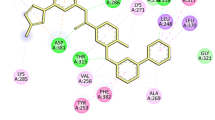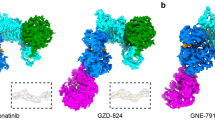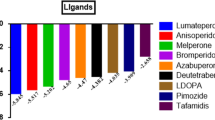Abstract
Context
Parkinson's disease is a neurodegenerative condition characterized by the degeneration of dopaminergic neurons, resulting in motor disabilities such as rigidity, bradykinesia, postural instability, and resting tremors. While the exact cause of Parkinson's remains uncertain, both familial and sporadic forms are often associated with the G2019S mutation found in the kinase domain of LRRK2. Roco4 is an analogue of LRRK2 protein in Dictyostelium discoideum which is an established model organism to investigate LRRK2 inhibitors. In this study, the potential treatment of Parkinson's was explored by inhibiting the activity of the mutated LRRK2 protein using Roco4 as the base protein structure. Mongolicain-A and Bacoside-A exhibited significant selectivity towards the G2019S mutation, displaying a binding affinity of − 12.3 Kcal/mol and − 11.4 Kcal/mol respectively. Mongolicain-A demonstrated increased specificity towards Roco4, while Bacoside-A demonstrated significant binding affinity to all 34 kinases proteins alike. The Molecular Dynamics Studies (MDS) results strongly suggests that Mongolicain-A is a significant inhibitor of Roco4 kinase. ADMET and drugability analysis also suggests that among the two best ligands, Mongolicain-A demonstrates significant physicochemical properties to be suitable for best drug like molecule. Based on the in-silico molecular docking, molecular dynamic simulation, ADMET and drugability analyses, it is strongly suggested that, Mongolicain-A could be a potential candidate for treatment and management of Parkinson’s disease via inhibition of LRRK2 protein. Further in-vitro and in-vivo investigations are in demand to validate these findings.
Methods
To identify potential inhibitors, 3069 phytochemicals were screened using molecular docking via AutoDock Vina. Molecular Dynamics Simulation was carried out using GROMACS 2022.2 for a duration of 100ns per complex to study the stability and inhibition potential of the protein ligand complexes. ADMET analysis was carriedout using Molinspiration and preADMET web tool.






Similar content being viewed by others
References
Abdul Manap AS, Vijayabalan S, Madhavan P, Chia YY, Arya A, Wong EH, Rizwan F, Bindal U, Koshy S (2019) Bacopa monnieri, a neuroprotective lead in Alzheimer disease: a review on its properties, mechanisms of action, and preclinical and clinical studies. Drug Target Insights 13:1177392819866412. https://doi.org/10.1177/1177392819866412
Antony PMA, Diederich NJ, Krüger R, Balling R (2013) The hallmarks of Parkinson’s disease. FEBS J 280(23):5981–5993. https://doi.org/10.1111/febs.12335
Berman HM, Westbrook J, Feng Z, Gilliland G, Bhat TN, Weissig H, Shindyalov IN, Bourne PE (2000) The Protein Data Bank. Nucleic Acids Res 28(1):235–242. https://doi.org/10.1093/nar/28.1.235
Chen C-Y, Weng Y-H, Chien K-Y, Lin K-J, Yeh T-H, Cheng Y-P, Lu C-S, Wang H-L (2012) (G2019S) LRRK2 activates MKK4-JNK pathway and causes degeneration of SN dopaminergic neurons in a transgenic mouse model of PD. Cell Death Differ 19(10):1623–1633. https://doi.org/10.1038/cdd.2012.42
Chen M-L, Wu R-M (2018) LRRK 2 gene mutations in the pathophysiology of the ROCO domain and therapeutic targets for Parkinson’s disease: a review. J Biomed Sci 25(1):52. https://doi.org/10.1186/s12929-018-0454-0
Choi HG, Zhang J, Deng X, Hatcher JM, Patricelli MP, Zhao Z, Alessi DR, Gray NS (2012) Brain penetrant LRRK2 inhibitor. ACS Med Chem Lett 3(8):658–662. https://doi.org/10.1021/ml300123a
de Rus Jacquet A, Tancredi JL, Lemire AL, DeSantis MC, Li W-P, O’Shea EK (2021) The LRRK2 G2019S mutation alters astrocyte-to-neuron communication via extracellular vesicles and induces neuron atrophy in a human iPSC-derived model of Parkinson’s disease. eLife 10. https://doi.org/10.7554/eLife.73062
Ferreira LLG, Andricopulo AD (2019) ADMET modeling approaches in drug discovery. Drug Discov Today 24(5):1157–1165. https://doi.org/10.1016/j.drudis.2019.03.015
Gilsbach BK, Messias AC, Ito G, Sattler M, Alessi DR, Wittinghofer A, Kortholt A (2015) Structural characterization of LRRK2 inhibitors. J Med Chem 58(9):3751–3756. https://doi.org/10.1021/jm5018779
Gloeckner CJ, Schumacher A, Boldt K, Ueffing M (2009) The Parkinson disease-associated protein kinase LRRK2 exhibits MAPKKK activity and phosphorylates MKK3/6 and MKK4/7, in vitro. J Neurochem 109(4):959–968. https://doi.org/10.1111/j.1471-4159.2009.06024.x
Hatcher JM, Choi HG, Alessi DR, Gray NS (2017) Small-molecule inhibitors of LRRK2. Adv Neurobiol 14:241–264. https://doi.org/10.1007/978-3-319-49969-7_13
Holcomb L, Dhanasekaran M, Hitt A, Young K, Riggs M, Manyam B (2006) Bacopa monniera extract reduces amyloid levels in PSAPP mice. J Alzheimer’s Dis: JAD 9:243–251. https://doi.org/10.3233/JAD-2006-9303
Hsu CH, Chan D, Greggio E, Saha S, Guillily MD, Ferree A, Raghavan K, Shen GC, Segal L, Ryu H, Cookson MR, Wolozin B (2010) MKK6 binds and regulates expression of Parkinson’s disease-related protein LRRK2. J Neurochem 112(6):1593–1604. https://doi.org/10.1111/j.1471-4159.2010.06568.x
Kamaraj B, Purohit R (2016) Mutational analysis on membrane associated transporter protein (MATP) and their structural consequences in oculocutaeous albinism type 4 (OCA4)-A molecular dynamics approach. J Cell Biochem 117(11):2608–2619. https://doi.org/10.1002/jcb.25555
Kim S (2016) Getting the most out of PubChem for virtual screening. Expert Opin Drug Discov 11(9):843–855. https://doi.org/10.1080/17460441.2016.1216967
Kumar GP, Khanum F (2012) Neuroprotective potential of phytochemicals. Pharmacogn Rev 6(12):81–90. https://doi.org/10.4103/0973-7847.99898
Lee JH, Han J, Kim H, Park SM, Joe E, Jou I (2019) Parkinson’s disease-associated LRRK2-G2019S mutant acts through regulation of SERCA activity to control ER stress in astrocytes. Acta Neuropathol Commun 7(1):68. https://doi.org/10.1186/s40478-019-0716-4
Lesage S, Dürr A, Tazir M, Lohmann E, Leutenegger A-L, Janin S, Pollak P, Brice A (2006) LRRK2 G2019S as a cause of Parkinson’s disease in North African Arabs. N Engl J Med 354(4):422–423. https://doi.org/10.1056/NEJMc055540
Liu G, Sgobio C, Gu X, Sun L, Lin X, Yu J, Parisiadou L, Xie C, Sastry N, Ding J, Lohr KM, Miller GW, Mateo Y, Lovinger DM, Cai H (2015) Selective expression of Parkinson’s disease-related Leucine-rich repeat kinase 2 G2019S missense mutation in midbrain dopaminergic neurons impairs dopamine release and dopaminergic gene expression. Hum Mol Genet 24(18):5299–5312. https://doi.org/10.1093/hmg/ddv249
Longo F, Mercatelli D, Novello S, Arcuri L, Brugnoli A, Vincenzi F, Russo I, Berti G, Mabrouk OS, Kennedy RT, Shimshek DR, Varani K, Bubacco L, Greggio E, Morari M (2017) Age-dependent dopamine transporter dysfunction and Serine129 phospho-α-synuclein overload in G2019S LRRK2 mice. Acta Neuropathol Commun 5(1):22. https://doi.org/10.1186/s40478-017-0426-8
Lu W, Zhang Y, Tan Y-Z, Hu K-L, Jiang X-G, Fu S-K (2005) Cationic albumin-conjugated pegylated nanoparticles as novel drug carrier for brain delivery. J Control Release: Off J Control Release Soc 107(3):428–448. https://doi.org/10.1016/j.jconrel.2005.03.027
Oanca G, van der Ent F, Åqvist J (2023) Efficient empirical valence bond simulations with GROMACS. J Chem Theory Comput 19(17):6037–6045. https://doi.org/10.1021/acs.jctc.3c00714
Ozelius LJ, Senthil G, Saunders-Pullman R, Ohmann E, Deligtisch A, Tagliati M, Hunt AL, Klein C, Henick B, Hailpern SM, Lipton RB, Soto-Valencia J, Risch N, Bressman SB (2006) LRRK2 G2019S as a cause of Parkinson’s disease in Ashkenazi Jews. N Engl J Med 354(4):424–425. https://doi.org/10.1056/NEJMc055509
Shah FH, Kim SJ (2022) Inhibitors of EYA3 protein in Ewing sarcoma. Asian Pac J Cancer Prev: APJCP 23(5):1539–1545. https://doi.org/10.31557/APJCP.2022.23.5.1539
Singh R, Bhardwaj V, Purohit R (2021) Identification of a novel binding mechanism of quinoline based molecules with lactate dehydrogenase of Plasmodium falciparum. J Biomol Struct Dyn 39(1):348–356. https://doi.org/10.1080/07391102.2020.1711809
Soudani W, Hadjadj-Aoul FZ, Bouachrine M, Zaki H (2021) Molecular docking of potential cytotoxic alkylating carmustine derivatives 2-chloroethylnitrososulfamides analogues of 2-chloroethylnitrosoureas. J Biomol Struct Dyn 39(12):4256–4269. https://doi.org/10.1080/07391102.2020.1776638
Van Den Eeden SK, Tanner CM, Bernstein AL, Fross RD, Leimpeter A, Bloch DA, Nelson LM (2003) Incidence of Parkinson’s disease: variation by age, gender, and race/ethnicity. Am J Epidemiol 157(11):1015–1022. https://doi.org/10.1093/aje/kwg068
Velmurugan BK, Rathinasamy B, Lohanathan BP, Thiyagarajan V, Weng C-F (2018) Neuroprotective role of phytochemicals. Molecules 23(10). https://doi.org/10.3390/molecules23102485
Venkatesan R, Ji E, Kim SY (2015) Phytochemicals that regulate neurodegenerative disease by targeting neurotrophins: a comprehensive review. Biomed Res Int 2015:814068. https://doi.org/10.1155/2015/814068
Walter J, Bolognin S, Poovathingal SK, Magni S, Gérard D, Antony PMA, Nickels SL, Salamanca L, Berger E, Smits LM, Grzyb K, Perfeito R, Hoel F, Qing X, Ohnmacht J, Bertacchi M, Jarazo J, Ignac T, Monzel AS, …, Schwamborn JC (2021) The Parkinson’s-disease-associated mutation LRRK2-G2019S alters dopaminergic differentiation dynamics via NR2F1. Cell Rep 37(3):109864. https://doi.org/10.1016/j.celrep.2021.109864
Waterhouse A, Bertoni M, Bienert S, Studer G, Tauriello G, Gumienny R, Heer FT, de Beer TAP, Rempfer C, Bordoli L, Lepore R, Schwede T (2018) SWISS-MODEL: homology modelling of protein structures and complexes. Nucleic Acids Res 46(W1):W296–W303. https://doi.org/10.1093/nar/gky427
West AB (2017) Achieving neuroprotection with LRRK2 kinase inhibitors in Parkinson disease. Exp Neurol 298(Pt B):236–245. https://doi.org/10.1016/j.expneurol.2017.07.019
Williams JC, Kalyaanamoorthy S (2021) PoseFilter: a PyMOL plugin for filtering and analyzing small molecule docking in symmetric binding sites. Bioinformatics (Oxford, England) 37(19):3367–3368. https://doi.org/10.1093/bioinformatics/btab188
Acknowledgements
The authors thank the management of MS Ramaiah University of Applied Sciences, India, and University of Trieste, Italy, for supporting this research work.
Author information
Authors and Affiliations
Contributions
K.D and L.R executed the bioinformatics analysis.
K.D and L.R wrote the main manuscript.
L.R revised and reviewed the final manuscirpt.
Corresponding author
Ethics declarations
Competing interests
The authors declare no competing interests.
Additional information
Publisher's Note
Springer Nature remains neutral with regard to jurisdictional claims in published maps and institutional affiliations.
Preprint
The authors would like to disclose that, the manuscript has been uploaded as a preprint in the BioRixv server with https://doi.org/10.1101/2023.10.21.563412.
Rights and permissions
Springer Nature or its licensor (e.g. a society or other partner) holds exclusive rights to this article under a publishing agreement with the author(s) or other rightsholder(s); author self-archiving of the accepted manuscript version of this article is solely governed by the terms of such publishing agreement and applicable law.
About this article
Cite this article
Dutta, K., Ravi, L. Molecular dynamic investigation for Roco4 kinase inhibitor as treatment options for parkinsonism. J Mol Model 30, 133 (2024). https://doi.org/10.1007/s00894-024-05925-0
Received:
Accepted:
Published:
DOI: https://doi.org/10.1007/s00894-024-05925-0




